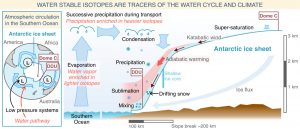A new isotope-enabled climate model dedicated to polar studies, to reconstruct Antarctic climate variability and improve sea level rise projections (projet Marie Curie – Cécile Agosta)
The rate of Antarctic ice loss is accelerating and reached 20% of the global sea level rise in 2012–2017. This acceleration is attributed to the coupling between atmosphere, ocean, and ice sheet dynamics. Intensive efforts are in place for modelling this complex coupled system, which is the only valid approach to improve sea level rise projections. However, the greatest uncertainty in simulating the future of the Antarctic ice sheet is due to the lack of direct observational constraints required to evaluate and improve global climate models. The isotopic signals contained in Antarctic ice cores have high potential to record the climate variability of recent centuries as water stable isotopes are tracers of the whole water cycle pathway. However, linking the isotopic signal to climate patterns requires to use isotope-enabled climate models, which are currently limited by their poor skills in simulating polar-specific processes.
The POLARISO project aims to overcome this major limitation by implementing water stable isotopes in a polar-oriented regional climate model, which will be evaluated with new isotope observations in Antarctica. We will then use the validated simulations to identify large scale drivers of the isotope variability at the Antarctic surface. This project is based on a synergy between advances in Antarctic climate modelling (PI) and advances in continuous measurements of water isotopes in water vapor and precipitation in Antarctica (host). The POLARISO project will provide robust transfer functions between climate modes and water isotope variability, which will open doors for new climate reconstructions based on water isotope measurements in Antarctic deep and shallow ice cores.

